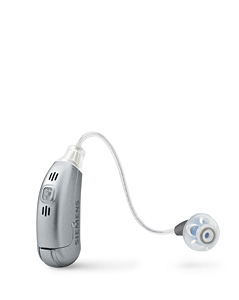Details on the Siemens Pure 700
Severe deafness is complicated. To say the least. When I decided it was time to change gadgets and keep up with technology, I realized that it was a very tiring search, but one that should be done with love and care. Otherwise, the chance of disappointment is very high.
After months of researching the subject on the internet, I made up my mind. I opted for the Siemens Pure 700 model.
The Pure 700
The Pure 700 is almost imperceptible. Okay, I’m years past the stage of caring whether or not anyone can see my devices. The intracanal ones I use today are almost invisible, they only show up if I have my hair up. Anyone who says that discretion isn’t important when it comes to hearing aids is lying. Nobody likes to feel invaded by prying eyes. Discretion was the number one factor for me when making a choice like that. Not anymore.
The Pure 700 is like that:
Technologies it has:
– Receiver in the channel (RIC): the receiver is outside the device, making it smaller and more discreet.
– High power: despite its small size, it has several power levels to suit different levels of hearing loss. It caters for mild to moderately severe hearing loss.
– Bluetooth connection to audio equipment such as cell phones and TVs, even if the audio equipment doesn’t have Bluetooth: for these cases, Tek comes with the Tek Transmiter, which is a Bluetooth adapter. For example, you plug this adapter into the TV and it has a Bluetooth connection to connect to your hearing aids.
– DataLearning: a feature that learns the user’s setting preferences. This means that after a few days of use, the device learns your preferences and adjusts automatically. The more you use it, the less you need to adjust it.
– SoundSmoothing: many hearing aids already have technology to reduce continuous noise, such as air conditioning, so that the device amplifies speech and reduces noise, offering better sound quality. But Pure, in addition to reducing continuous noise, offers a feature that reduces abrupt no ises such as the sound of cymbals clattering. These are very short, loud noises that annoy people who use devices. With this feature, for example, conversation over dinner becomes much easier.
– Rechargeable batteries: it’s great not to have to worry about buying batteries and handling them ( older patients have difficulty handling very small parts, even I do!). Pure can be charged overnight. It only needs 5 hours to be charged for the next full day of use.
From what I’ve researched, the Pure ‘s main advantages over similar devices from other brands are its small size, performance, rechargeable batteries and Bluetooth connection. Some of these items can even be found in similar devices, but not all in a single device.
Tek is a conventional remote control (it adjusts the device’s program and volume functions and controls the battery level) and also has a Bluetooth connection function. It’s what connects the Pure to the TV, cell phone, iPod, MP3 player, PC…
***yes, I would love to talk on the phone or even listen to my iPod through the device, HOWEVER, I won’t make any great expectations of it. Listening to music through hearing aids is very strange. And I haven’t spoken on the phone for so many years that I don’t even remember what it’s like.
The truth is that people have higher expectations of this than I do. I even ask myself , ‘Gee, is someone going to die if they can’t get off the phone with me? Joking aside, this is a stress factor for me. It’s not because the device connects to the phone that I’m going to plug it in and talk – I wish it were that simple!
There are other conventional remote controls without the Bluetooth connection: ePen (looks like a pen, won a design award abroad) and ProPocket. Even if you use two devices, you only need one Tek. The devices have a technology called e2e wireless 2.0, which allows the two devices to communicate wirelessly.
So when you adjust the volume or program of one of them, the other adjusts automatically. Having the two devices in sync allows for better sound localization, i.e. identifying where the sound is coming from. This isn’t just about hearing comfort, however. It also concerns security. Example: when crossing the street, you can easily identify where the car horn is coming from.
With e2e wireless, the two hearing aids act as a single binaural system.
Has anyone used this model? Or do you know someone who does? Tell me! 🙂
Now I’m going to go through the boring, stressful and tiring part: fitting the prostheses with the speech therapist. After many years, I’ve learned that it’s definitely the issue that should be taken most seriously. As I’ve already written in another post, things don’t happen by magic, and it’s not in the first minute after adding your new friend that you’ll love him and he’ll reciprocate by working perfectly. It takes time!
Frustration, irritation, nervousness, fear. Everything! It takes a lot of “strength in the wig” to hold the bar and have enough energy to achieve a sound we like. And no, you shouldn’t be ashamed to go to the doctor’s as often as necessary. It’s the only way to take advantage of everything your new device has to offer. Don’t give up in the first few weeks!
Join the Deaf Who Hear Group
Click here to become a member.
READ MORE ABOUT HEARING AIDS
- NYTimes: Why are hearing aids so expensive?
- How to get a free hearing aid from SUS
- How much does a hearing aid cost?
- American Academy of Audiology: audiologist’s guide to ISADs, amplifiers and PSAPs
- Hearing aid prices in 2021
OUR SOCIAL NETWORKS
- Facebook group (23,000 people)
- Telegram group with chat
- Youtube
RECEIVE OUR NEWS BY EMAIL
See this photo on Instagram







